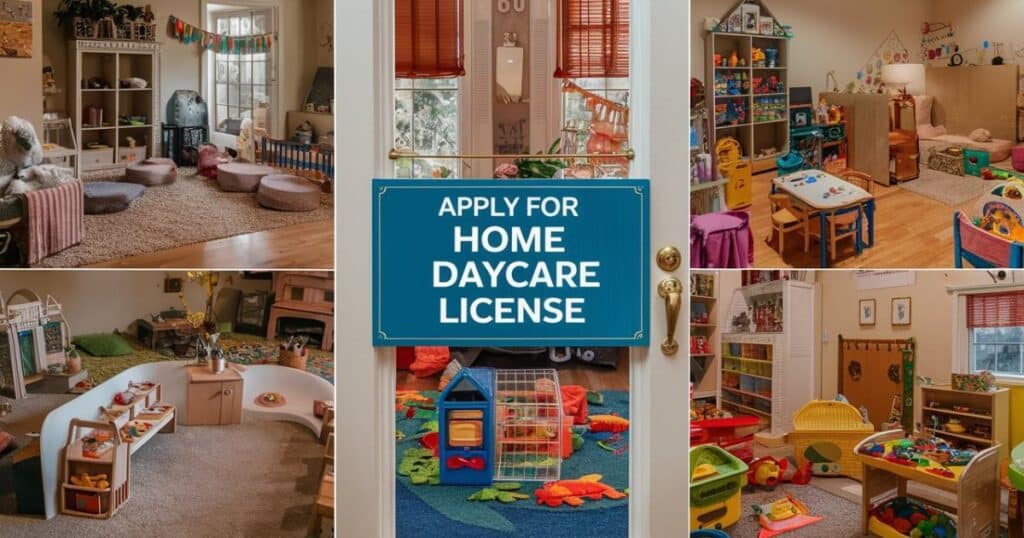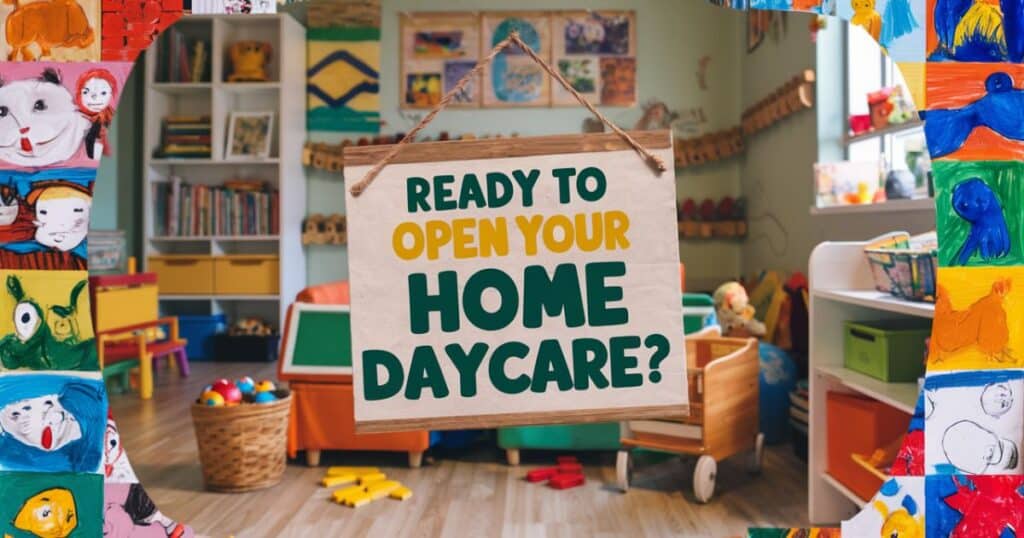Are you considering starting your home daycare? Delving into the world of childcare entrepreneurship can be both fulfilling and financially rewarding. Whether you’re passionate about working with children, seeking a flexible career, or aiming to contribute to your community, opening a daycare at home could be the perfect fit for you.
In this comprehensive guide, we’ll explore the essential steps and considerations involved in launching your home-based childcare business. From licensing requirements and safety protocols to creating a nurturing environment for young learners, let’s embark on the journey of turning your dream of owning a daycare into a thriving reality. Discover how to open a daycare at home and unlock the potential for a fulfilling and successful career in childcare.
Ready to turn your home into a nurturing haven for little ones? Learn how to open a daycare at home and embark on a rewarding childcare journey. Discover the steps to start your home-based daycare today.
But first, are you qualified to open a home daycare?
Before diving into the world of home daycare, it’s crucial to assess your qualifications. Are you equipped with the necessary skills and knowledge to care for young children? Consider your experience with childcare and any relevant certifications or training you may have.
Familiarize yourself with your local regulations and licensing requirements. Each region may have specific guidelines regarding home daycare operations, including minimum qualifications for providers. Ensure you meet these standards to operate legally and provide a safe environment for children.
Lastly, reflect on your passion and dedication to nurturing children. Opening a home daycare requires patience, energy, and a genuine love for working with kids. If you’re committed to providing quality care and enriching experiences for young learners, you may be well-suited to embark on this rewarding journey.
Apply for a Home Daycare License
To operate a home daycare legally, you’ll need to obtain a license from your local regulatory authority. Begin by researching the licensing requirements in your area, which may include background checks, safety inspections, and training programs. Once you understand the criteria, complete the necessary paperwork and submit your application for review.

After submitting your application, prepare for a home inspection to ensure your space meets safety standards. Address any potential hazards and make necessary modifications to create a secure environment for children. Once your home daycare license is approved, you can officially begin offering quality childcare services to families in your community.
Recommended Post: How To Get A Mobile Home Off My Property?
Children’s furniture
It is specially designed to meet the unique needs of young ones. It includes items like small chairs, tables, and beds that are sized just right for kids. These pieces are often colorful, durable, and easy to clean, making them perfect for the playful and sometimes messy world of childhood.
Equipment and toys for developmentally appropriate activities
| Activity Type | Equipment/Toy |
| Gross Motor Skills | Soft foam balls, balance beams, tunnels, ride-on toys |
| Fine Motor Skills | Sorting blocks, stacking cups, lacing beads, pegboards |
| Cognitive Development | Shape sorters, puzzles, memory games, building blocks |
| Sensory Exploration | Sensory bins filled with rice, sand, or water, textured balls, playdough |
| Language Development | Picture books, puppets, flashcards, musical instruments |
| Social Skills | Dolls with accessories, play kitchen sets, board games |
Also Read This Post: How Much Does It Cost To Live In A Group Home?
Nap time needs
- Comfortable Sleeping Surfaces: Ensure each child has a cozy and safe place to rest, such as individual cots, cribs, or sleeping mats.
- Soft Bedding: Provide soft blankets and pillows to promote comfort during nap time.
- Dim Lighting: Create a calming environment by dimming the lights or using curtains to block out excessive sunlight.
- White Noise or Soft Music: Use soothing sounds to help children relax and drown out background noise.
- Routine: Establish a consistent nap time routine, including activities like reading stories or singing songs to signal that it’s time to wind down.
- Comfort Items: Allow children to bring their favorite stuffed animals or blankets from home to provide a sense of security.
- Supervision: Ensure adequate supervision during nap time to monitor children and promote safety.
Mealtime supplies
For mealtime supplies, it’s essential to have everything ready to create a smooth and enjoyable dining experience for the children. This includes child-sized plates, bowls, cups, and utensils to promote independence and develop self-feeding skills. Additionally, having a variety of bibs or smocks on hand helps keep clothes clean during meals. Ensure you have a highchair or booster seat for each child, adjustable to their size and needs.
Stock up on spill-proof sippy cups and small pitchers for serving drinks safely. It’s also crucial to have a selection of nutritious snacks and meals prepared or easily accessible, taking into account any dietary restrictions or allergies. Finally, maintain a clean and organized eating area, with wipes or washcloths readily available for quick clean-ups as needed.
Entryway items
Coat Rack: Provide a sturdy coat rack or hooks for children to hang their coats and bags upon arrival.
Shoe Storage: Allocate space for shoe storage, such as a designated area or shoe rack, to keep entryways tidy and organized.
Cubbyholes or Baskets: Assign each child a cubby hole or basket to store personal belongings like hats, gloves, and extra clothing items.
Welcome Sign: Create a welcoming atmosphere with a colorful and inviting welcome sign or poster displayed near the entryway.
Bulletin Board: Install a bulletin board where important announcements, schedules, and reminders can be posted for parents’ reference.
Hand Sanitizer or Hand Washing Station: Set up a hand sanitizer dispenser or handwashing station near the entryway to promote good hygiene practices upon arrival.
Seating Area: Provide a small seating area with benches or chairs where children and parents can comfortably remove and store outdoor gear before entering the childcare space.
Storage Bins or Hooks for Backpacks: Offer storage bins or hooks specifically for backpacks to ensure they’re easily accessible yet out of the way.
Bathroom and changing station
A well-equipped bathroom and changing station are crucial for maintaining cleanliness and ensuring comfort in childcare settings. Stocked with child-friendly supplies, including soap, towels, diapers, and wipes, these areas promote hygiene and convenience for both children and caregivers.
First aid kit
A first aid kit is a vital component of any childcare facility, providing essential supplies to handle minor injuries and medical emergencies. Stocked with bandages, antiseptic wipes, adhesive tape, and other basic medical items, a well-prepared first aid kit ensures prompt and effective care for children in need.
Other health and safety requirements
In addition to a first aid kit, childcare facilities must adhere to various health and safety requirements to ensure the well-being of children. This includes maintaining a clean and sanitary environment, implementing regular cleaning and disinfection protocols, conducting safety inspections of play areas and equipment, and adhering to applicable licensing regulations and guidelines.
Promoting healthy hygiene practices, providing nutritious meals and snacks, and having emergency procedures in place are essential aspects of ensuring the health and safety of children in childcare settings.
Establish Your Business
Establishing your childcare business involves several key steps, including registering your business, obtaining necessary permits and licenses, setting up a safe and welcoming space for children, and developing policies and procedures.

Creating a business plan outlining your services, target market, pricing structure, and marketing strategies is essential for success. By taking these steps, you can lay a solid foundation for your childcare venture and ensure compliance with legal and regulatory requirements.
Become a “Sole Proprietor”
Becoming a ‘Sole Proprietor’ means you are the only owner of your business. It’s a simple and common way to start a small business. As a sole proprietor, you have full control over your business decisions and keep all the profits, but you’re also personally responsible for any debts or legal issues.
Keep taxes in mind
Keeping taxes in mind is crucial when running a business. Make sure to track your income and expenses, set aside money for taxes regularly, and consider consulting a tax professional for guidance. By staying organized and proactive with your tax obligations, you can avoid surprises and ensure compliance with tax laws.
Get insured
Getting insured is essential for protecting your childcare business. Look into liability insurance to cover accidents or injuries that may occur on your premises. Additionally, consider insurance for your property and equipment, as well as coverage for your employees. By having the right insurance in place, you can safeguard your business against unexpected events and ensure peace of mind for yourself and your clients.
Find Your First Families
Finding your first family is an exciting step in launching your childcare business. Spread the word in your community through word of mouth, social media, and local advertising. Offer promotional deals or discounts to attract new clients.
Build trust by highlighting your qualifications, experience, and dedication to providing quality care. By connecting with families who share your values and vision, you can establish strong relationships and lay the foundation for a successful childcare venture.
Set up online profiles
Setting up online profiles is a crucial step in marketing your childcare business. Create profiles on popular platforms like social media networks, childcare directories, and your website. Provide essential information such as your services, location, contact details, and any special offerings or qualifications.
Use engaging photos and testimonials to showcase your facilities and happy families. By establishing a strong online presence, you can reach a wider audience and attract potential clients searching for childcare options.
Spread the word
Spreading the word means telling people about something. It’s like sharing news or information with others so they know about it too. You can spread the word by talking to friends, family, and neighbors, or by using social media and other ways to reach more people.
Get enrollments
Getting enrollments means signing up children to attend your childcare program. This involves parents or guardians choosing your childcare service for their child and completing the necessary paperwork to officially enroll them. You can attract enrollments by promoting your program, showcasing your facilities and services, and offering incentives or discounts to interested families.
Opening Day & Beyond
Opening Day marks the beginning of your childcare journey. Beyond that, it’s about providing excellent care, fostering growth, and building lasting relationships with children and families. Stay committed to creating a safe, nurturing environment, and continue to adapt and improve your services based on feedback and experiences. As you embark on this journey, remember that each day presents new opportunities to make a positive impact on the lives of the children in your care.
Daily
Daily refers to something that happens every day. In the context of childcare, it involves the routine tasks and activities that occur regularly, such as feeding, napping, playing, and learning. Establishing a daily schedule helps create structure and consistency for children, promoting their well-being and development.
Weekly
Weekly means something that happens once every week. In childcare, weekly activities might include planning lesson plans, conducting staff meetings, organizing outings or special events, and communicating with parents about their child’s progress. Establishing a weekly routine helps maintain organization and ensures that important tasks are completed efficiently.
Monthly
Monthly refers to something that occurs once every month. In childcare, monthly tasks might include updating enrollment records, reviewing financial reports, conducting safety inspections, and planning for upcoming events or curriculum changes. Setting aside time each month to address these responsibilities helps maintain the smooth operation of the childcare facility and ensures ongoing compliance with regulations and standards.
Quarterly
Quarterly means something that happens every three months. In childcare, quarterly activities may involve conducting performance evaluations for staff members, reviewing and updating policies and procedures, assessing the effectiveness of curriculum and programming, and evaluating the overall operation of the childcare facility. These quarterly assessments help ensure continuous improvement and alignment with the goals and objectives of the childcare program.
Yearly
Yearly refers to something that occurs once a year. In childcare, yearly tasks may include renewing licenses and certifications, conducting comprehensive safety audits, reviewing and updating emergency preparedness plans, and evaluating the overall effectiveness of the childcare program. These yearly assessments help ensure compliance with regulatory requirements, maintain a safe and nurturing environment for children, and support the continuous improvement of the childcare facility.
Ready to Open Your Home Daycare?
Are you ready to open your home daycare? It’s an exciting journey that starts with careful planning. First, make sure you meet all the requirements and get any necessary licenses. Next, create a safe and welcoming space for the children. Finally, promote your daycare to families in your community.
Opening your home daycare means providing a nurturing environment for children to learn and grow. You’ll need to set up daily routines, plan activities, and ensure the safety of every child in your care. With dedication and love, you can make a positive impact on the lives of the children and families you serve.

Remember, running a home daycare requires patience, flexibility, and a passion for working with children. Be prepared for challenges along the way, but also celebrate the joys and milestones that come with nurturing young minds. With your commitment and determination, you can build a successful and fulfilling career in childcare.
Bridget Garsh
Bridget Garsh is a writer, educator, and advocate for children and families. She is passionate about early childhood education and empowering parents to support their children’s development. Through her writing and work, Bridget strives to create inclusive and supportive communities where every child has the opportunity to thrive. She shares her insights and experiences on topics such as parenting, education, and child advocacy to inspire and inform others.
Conclusion
Opening a daycare at home is an endeavor filled with both excitement and challenges. It requires careful planning, dedication, and a genuine love for working with children. By following the steps outlined in this guide, including obtaining necessary licenses, creating a safe and nurturing environment, and promoting your services to families in your community, you can embark on a rewarding journey of entrepreneurship in childcare.
It’s essential to remember that running a home daycare is not without its difficulties. It requires patience, flexibility, and a willingness to adapt to the needs of both children and parents. Despite the inevitable challenges, the opportunity to make a positive impact on the lives of young children and their families is immeasurable. With commitment, passion, and ongoing learning, you can create a thriving home daycare that enriches the lives of all who walk through its doors.
Frequently Asked Questions
How do I start daycare?
- Research requirements.
- Create a business plan.
- Obtain licenses.
- Prepare space.
- Market services.
What are the requirements to open a daycare in NY?
- OCFS license.
- Background checks.
- CPR/First Aid.
- Health/safety standards.
How many kids can I watch without a license in SC?
Up to six, including my kids.
How many kids can you babysit without a license in Mo?
Up to four unrelated children.

Warner Clips is an expert writer with 4 years of experience crafting engaging content on Home topics. My expertise ranges from creating cozy environments to tackling Home Improvement projects. Find my work in publications like Huffington Post and Reader’s Digest.







